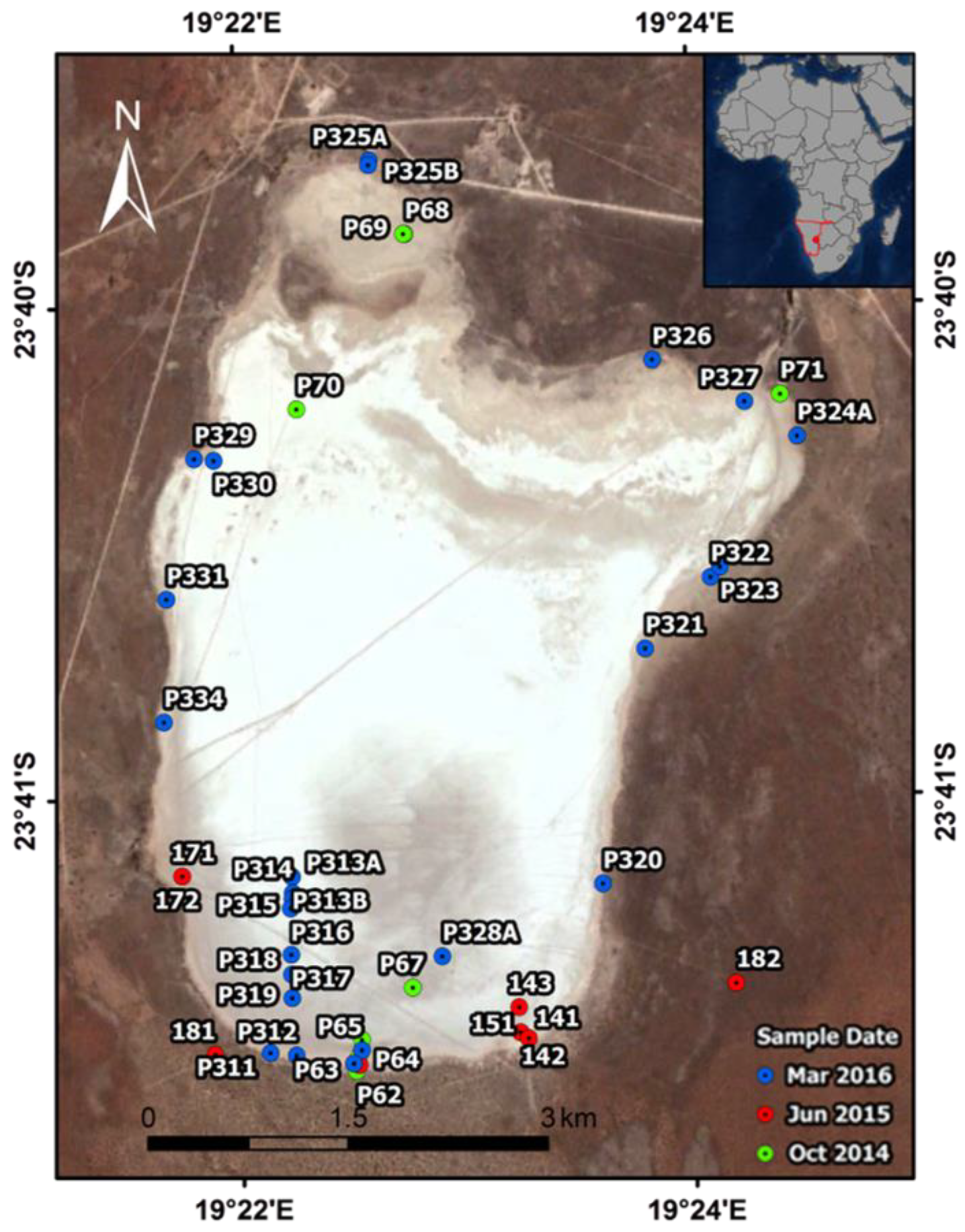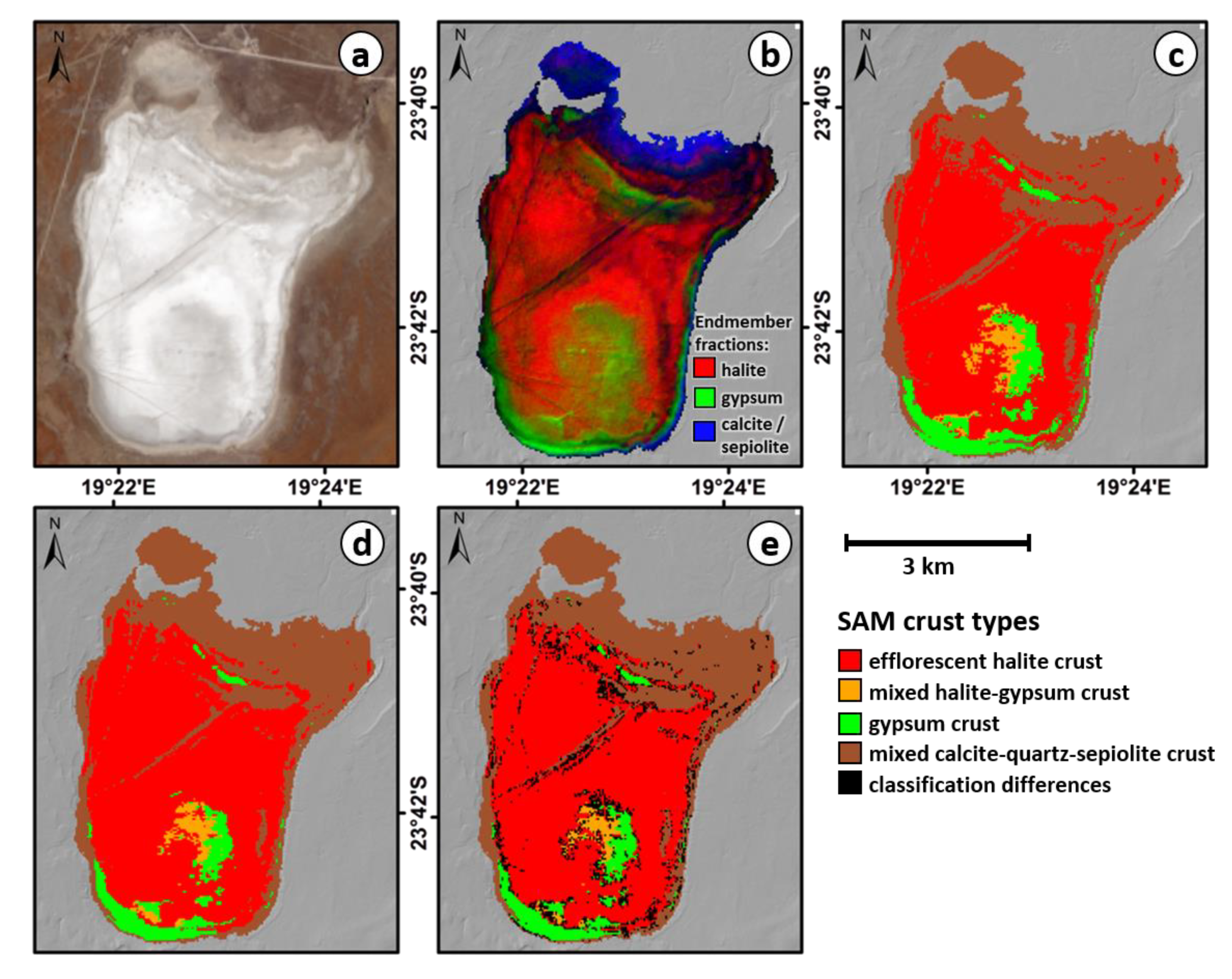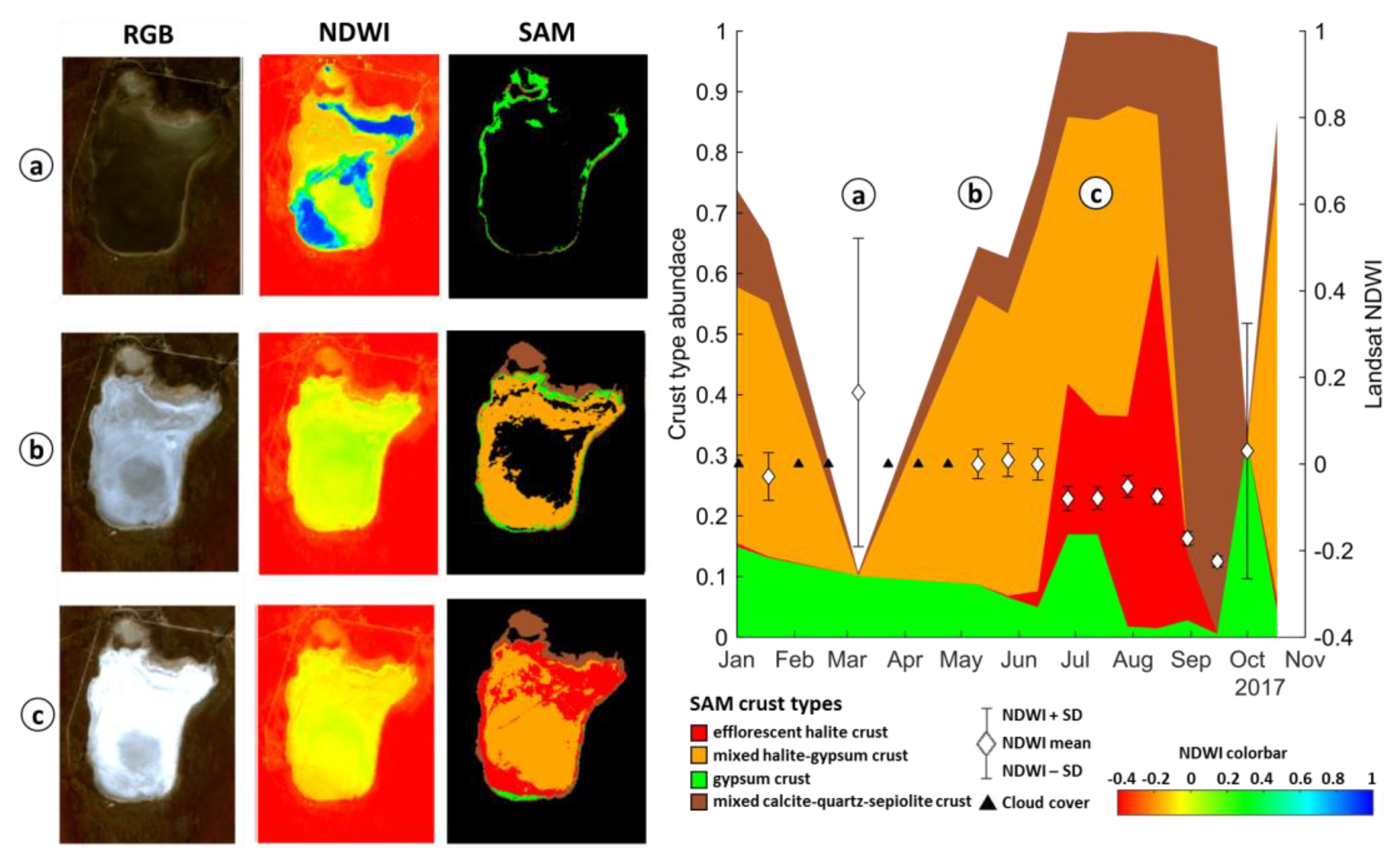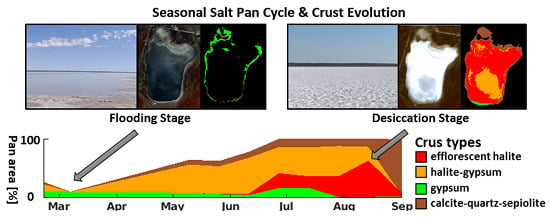Analyses of Namibian Seasonal Salt Pan Crust Dynamics and Climatic Drivers Using Landsat 8 Time-Series and Ground Data
Abstract
:1. Introduction
2. Study Area
2.1. Regional Setting
2.2. Seasonal Surface Dynamics
3. Materials and Methods
3.1. Field and Laboratory Analysis
3.2. Remote Sensing Analysis
3.2.1. Salt Pan Crust Type Endmember Definition
3.2.2. Salt Pan Crust Type Mapping and Validation
3.2.3. Dynamics of Omongwa Pan Surface
4. Results
4.1. Crust-Type Endmember Definition
4.2. Crust-Type Mapping and Validation
4.3. Dynamics of Omongwa Pan Surface
5. Discussion
5.1. Interannual Surface Flooding-Desiccation Cycle Characterization
5.2. Influence of Climatic Variables on Multiannual Crust Type Dynamics
- After wet conditions at the surface of the pan due to major flooding or smaller rain events, first, a mixed gypsum–halite crust appears in less moist parts of the surfaces. Further in the dry season, a successive transition of mixed gypsum–halite to bright efflorescent halite crust is observed, where the aerial coverage of bright halite crust can reach up to 80% of the total pan surface after several months of dry conditions. Then, a transition of bright halite to mixed calcite–quartz–sepiolite crust type is observed at the end of the dry season that can be depending on the years more or less strong. This transition precedes the arrival of wet conditions that depending on the size and occurrence of rain events produce more, or less long or shorter flooding conditions, and disappearance of the surface crust.
- After the wet season, the build-up of mixed halite gypsum crust is observed independent of the occurrence of big or small flooding events. Thus, the build-up of mixed halite–gypsum crust at the beginning of the desiccation stage does not rely on an extensive flooding event to redistribute the salt minerals, but results from the combined effect of evaporation and capillary rise to develop these crusts from subsurface brines. Driven by lower temperature in the cold winter month an extensive efflorescent halite crust develops, due to higher relative humidity at night-time.
- In the strong wind season, of the late summer to early autumn months (August to October) associated with the end of the dry season and the start of the new wet season, the areal coverage of crust types is changing from bright efflorescent halite crust to a more mixed calcite–quartz–sepiolite crust endmember. Greater or smaller changes in crust development are observed, depending on the year. Nevertheless, the amount of change seems to be mainly driven by wind speed and exposure. This change is mostly attributed to the removal of efflorescent halite crust by wind erosion processes. In this time period, increased dust emission can thus be expected.
6. Conclusions
Author Contributions
Funding
Acknowledgments
Conflicts of Interest
References
- Crowley, J.K.; Hook, S.J. Mapping playa evaporite minerals and associated sediments in Death Valley, California, with multispectral thermal infrared images. J. Geophys. Res. 1996, 101, 643–660. [Google Scholar] [CrossRef]
- Goudie, A.S.; Thomas, D.S.G. Pans in southern Africa with particular reference to South Africa and Zimbabwe. Z. FüR Geomorphol. 1985, 29, 1–19. [Google Scholar]
- Goudie, A.S.; Wells, G.L. The nature, distribution and formation of pans in arid zones. Earth-Sci. Rev. 1995, 38, 1–69. [Google Scholar] [CrossRef]
- Smoot, J.P.; Lowenstein, T.K. Chapter 3 Depositional Environments of Non-Marine Evaporites. In Developments in Sedimentology; Melvin, J.L., Ed.; Evaporites, Petroleum and Mineral Resources; Elsevier: Amsterdam, The Netherlands, 1991; Volume 50, pp. 189–347. [Google Scholar]
- Washington, R.; Todd, M.; Middleton, N.J.; Goudie, A.S. Dust-Storm Source Areas Determined by the Total Ozone Monitoring Spectrometer and Surface Observations. Ann. Assoc. Am. Geogr. 2003, 93, 297–313. [Google Scholar] [CrossRef]
- Prospero, J.M.; Ginoux, P.; Torres, O.; Nicholson, S.E.; Gill, T.E. Environmental Characterization of Global Sources of Atmospheric Soil Dust Identified with the Nimbus 7 Total Ozone Mapping Spectrometer (toms) Absorbing Aerosol Product. Rev. Geophys. 2002, 40, 1002. [Google Scholar] [CrossRef]
- Frie, A.L.; Dingle, J.H.; Ying, S.C.; Bahreini, R. The Effect of a Receding Saline Lake (The Salton Sea) on Airborne Particulate Matter Composition. Environ. Sci. Technol. 2017, 51, 8283–8292. [Google Scholar] [CrossRef]
- Reynolds, R.L.; Yount, J.C.; Reheis, M.; Goldstein, H.; Chavez, P.; Fulton, R.; Whitney, J.; Fuller, C.; Forester, R.M. Dust emission from wet and dry playas in the Mojave Desert, USA. Earth Surf. Process. Landforms 2007, 32, 1811–1827. [Google Scholar] [CrossRef]
- Baddock, M.C.; Bullard, J.E.; Bryant, R.G. Dust source identification using MODIS: A comparison of techniques applied to the Lake Eyre Basin, Australia. Remote Sens. Environ. 2009, 113, 1511–1528. [Google Scholar] [CrossRef] [Green Version]
- Chappell, A.; Strong, C.; McTainsh, G.; Leys, J. Detecting induced in situ erodibility of a dust-producing playa in Australia using a bi-directional soil spectral reflectance model. Remote Sens. Environ. 2007, 106, 508–524. [Google Scholar] [CrossRef]
- Ge, Y.; Abuduwaili, J.; Ma, L.; Wu, N.; Liu, D. Potential transport pathways of dust emanating from the playa of Ebinur Lake, Xinjiang, in arid northwest China. Atmos. Res. 2016, 178, 196–206. [Google Scholar] [CrossRef]
- Singer, A.; Zobeck, T.; Poberezsky, L.; Argaman, E. The PM10and PM2·5 dust generation potential of soils/sediments in the Southern Aral Sea Basin, Uzbekistan. J. Arid. Environ. 2003, 54, 705–728. [Google Scholar] [CrossRef]
- Todd, M.C.; Washington, R.; Martins, J.V.; Dubovik, O.; Lizcano, G.; M’Bainayel, S.; Engelstaedter, S. Mineral dust emission from the Bodélé Depression, northern Chad, during BoDEx 2005. J. Geophys. Res. 2007, 112, D06207. [Google Scholar] [CrossRef]
- Vickery, K.J.; Eckardt, F.D.; Bryant, R.G. A sub-basin scale dust plume source frequency inventory for southern Africa, 2005–2008. Geophys. Res. Lett. 2013, 40, 5274–5279. [Google Scholar] [CrossRef] [Green Version]
- Bryant, R.G. Monitoring hydrological controls on dust emissions: Preliminary observations from Etosha Pan, Namibia. Geogr. J. 2003, 169, 131–141. [Google Scholar] [CrossRef]
- Bryant, R.G.; Bigg, G.R.; Mahowald, N.M.; Eckardt, F.D.; Ross, S.G. Dust emission response to climate in southern Africa. J. Geophys. Res. 2007, 112, D09207. [Google Scholar] [CrossRef] [Green Version]
- Eckardt, F.D.; Bryant, R.G.; McCulloch, G.; Spiro, B.; Wood, W.W. The hydrochemistry of a semi-arid pan basin case study: Sua Pan, Makgadikgadi, Botswana. Appl. Geochem. 2008, 23, 1563–1580. [Google Scholar] [CrossRef]
- Pratt, K.A.; Twohy, C.H.; Murphy, S.M.; Moffet, R.C.; Heymsfield, A.J.; Gaston, C.J.; DeMott, P.J.; Field, P.R.; Henn, T.R.; Rogers, D.C.; et al. Observation of playa salts as nuclei in orographic wave clouds. J. Geophys. Res. 2010, 115, D15301. [Google Scholar] [CrossRef] [Green Version]
- Wood, W.W.; Sanford, W.E. Eolian transport, saline lake basins, and groundwater solutes. Water Resour. Res. 1995, 31, 3121–3129. [Google Scholar] [CrossRef]
- Bhattachan, A.; D’Odorico, P.; Okin, G.S. Biogeochemistry of dust sources in Southern Africa. J. Arid. Environ. 2015, 117, 18–27. [Google Scholar] [CrossRef]
- Plumlee, G.S.; Ziegler, T.L. The Medical Geochemistry of Dusts, Soils, and other Earth Materials: Chapter 7; Elsevier: Amsterdam, The Netherlands, 2003; Volume 9, ISBN 978-0-08-043751-4. [Google Scholar]
- Field, J.P.; Belnap, J.; Breshears, D.D.; Neff, J.C.; Okin, G.S.; Whicker, J.J.; Painter, T.H.; Ravi, S.; Reheis, M.C.; Reynolds, R.L. The ecology of dust. Front. Ecol. Environ. 2010, 8, 423–430. [Google Scholar] [CrossRef] [Green Version]
- Mees, F.; Singer, A. Surface crusts on soils/sediments of the southern Aral Sea basin, Uzbekistan. Geoderma 2006, 136, 152–159. [Google Scholar] [CrossRef]
- Buck, B.J.; King, J.; Etyemezian, V. Effects of Salt Mineralogy on Dust Emissions, Salton Sea, California. Soil Sci. Soc. Am. J. 2011, 75, 1971–1985. [Google Scholar] [CrossRef] [Green Version]
- Katra, I.; Lancaster, N. Surface-sediment dynamics in a dust source from spaceborne multispectral thermal infrared data. Remote Sens. Environ. 2008, 112, 3212–3221. [Google Scholar] [CrossRef]
- Thomas, A.D.; Dougill, A.J.; Elliott, D.R.; Mairs, H. Seasonal differences in soil CO2 efflux and carbon storage in Ntwetwe Pan, Makgadikgadi Basin, Botswana. Geoderma 2014, 219–220, 72–81. [Google Scholar] [CrossRef] [Green Version]
- Telfer, M.W.; Thomas, D.S.G.; Parker, A.G.; Walkington, H.; Finch, A.A. Optically Stimulated Luminescence (OSL) dating and palaeoenvironmental studies of pan (playa) sediment from Witpan, South Africa. Palaeogeogr. Palaeoclimatol. Palaeoecol. 2009, 273, 50–60. [Google Scholar] [CrossRef]
- Genderjahn, S.; Alawi, M.; Kallmeyer, J.; Belz, L.; Wagner, D.; Mangelsdorf, K. Present and past microbial life in continental pan sediments and its response to climate variability in the southern Kalahari. Org. Geochem. 2017, 108, 30–42. [Google Scholar] [CrossRef]
- Bryant, R.G. Validated linear mixture modelling of Landsat TM data for mapping evaporite minerals on a playa surface: Methods and applications. Int. J. Remote Sens. 1996, 17, 315–330. [Google Scholar] [CrossRef]
- Godfrey, L.V.; Chan, L.-H.; Alonso, R.N.; Lowenstein, T.K.; McDonough, W.F.; Houston, J.; Li, J.; Bobst, A.; Jordan, T.E. The role of climate in the accumulation of lithium-rich brine in the Central Andes. Appl. Geochem. 2013, 38, 92–102. [Google Scholar] [CrossRef]
- Reath, K.A.; Ramsey, M.S. Exploration of geothermal systems using hyperspectral thermal infrared remote sensing. J. Volcanol. Geotherm. Res. 2013, 265, 27–38. [Google Scholar] [CrossRef]
- Bryant, R.G. The Sedimentology and Geochemistry of Non-Marine Evaporites on the Chott el Djerid, Using Both Ground and Remotely Sensed Data. Ph.D. Thesis, University of Reading, Reading, UK, 1993. [Google Scholar]
- Ghrefat, H.A.; Goodell, P.C. Land cover mapping at Alkali Flat and Lake Lucero, White Sands, New Mexico, USA using multi-temporal and multi-spectral remote sensing data. Int. J. Appl. Earth Obs. Geoinf. 2011, 13, 616–625. [Google Scholar] [CrossRef]
- Crowley, J.K. Mapping playa evaporite minerals with AVIRIS data: A first report from death valley, California. Remote Sens. Environ. 1993, 44, 20. [Google Scholar] [CrossRef]
- Kodikara, G.R.L. Hyperspectral Mapping of Surface Mineralogy in the Lake Magadi Area in Kenya. Master’s Thesis, ITC, Enschede, The Netherlands, 2009. [Google Scholar]
- Hubbard, B.E.; Crowley, J.K. Mineral mapping on the Chilean–Bolivian Altiplano using co-orbital ALI, ASTER and Hyperion imagery: Data dimensionality issues and solutions. Remote Sens. Environ. 2005, 99, 173–186. [Google Scholar] [CrossRef]
- Epema, G.F. Spectral Reflectance in the Tunesian Desert. Ph.D. Thesis, Wageningen Agricultural University, Wageningen, The Netherlands, 1992. [Google Scholar]
- Li, J.; Menenti, M.; Mousivand, A.; Luthi, S.M. Non-Vegetated Playa Morphodynamics Using Multi-Temporal Landsat Imagery in a Semi-Arid Endorheic Basin: Salar de Uyuni, Bolivia. Remote Sens. 2014, 6, 10131–10151. [Google Scholar] [CrossRef] [Green Version]
- Flahaut, J.; Martinot, M.; Bishop, J.L.; Davies, G.R.; Potts, N.J. Remote sensing and in situ mineralogic survey of the Chilean salars: An analog to Mars evaporate deposits? Icarus 2017, 282, 152–173. [Google Scholar] [CrossRef] [Green Version]
- Wulder, M.A.; White, J.C.; Loveland, T.R.; Woodcock, C.E.; Belward, A.S.; Cohen, W.B.; Fosnight, E.A.; Shaw, J.; Masek, J.G.; Roy, D.P. The global Landsat archive: Status, consolidation, and direction. Remote Sens. Environ. 2016, 185, 271–283. [Google Scholar] [CrossRef] [Green Version]
- Roy, D.P.; Ju, J.; Mbow, C.; Frost, P.; Loveland, T. Accessing free Landsat data via the Internet: Africa’s challenge. Remote Sens. Lett. 2010, 1, 111–117. [Google Scholar] [CrossRef]
- Kautz, K.; Parada, H. Sepiolote formation in a pan of the Kalahari, South West Africa. J. Mineral. Geochem. 1976, 12, 545–559. [Google Scholar]
- Lancaster, N. Pans in the southwestern Kalahari. A preliminary report. Palaeoecol. Afr. 1986, 17, 59–68. [Google Scholar]
- Mees, F. Distribution patterns of gypsum and kalistrontite in a dry lake basin of the southwestern Kalahari (Omongwa pan, Namibia). Earth Surf. Process. Landforms 1999, 24, 731–744. [Google Scholar] [CrossRef]
- Milewski, R.; Chabrillat, S.; Behling, R. Analyses of Recent Sediment Surface Dynamic of a Namibian Kalahari Salt Pan Based on Multitemporal Landsat and Hyperspectral Hyperion Data. Remote Sens. 2017, 9, 170. [Google Scholar] [CrossRef] [Green Version]
- Mees, F.; Van Ranst, E. Micromorphology of sepiolite occurrences in recent lacustrine deposits affected by soil development. Soil Res. 2011, 49, 547–557. [Google Scholar] [CrossRef]
- Meteoblue. Historical Climate at Aminuis Region Based on on Global NOAA Environmental Modeling System (NEMS) Weather Model with ~30 km resolution. 2019. Available online: https://www.meteoblue.com/en/weather/historyclimate/climatemodelled/omongwa_namibia_3354434 (accessed on 1 June 2019).
- Atlas of Namibia Project. Directorate of Environmental Affairs, Minitry of Environment and Tourism. 2002. Available online: http://www.uni-koeln.de/sfb389/e/e1/download/atlas_namibia/e1_download_climate_e.htm (accessed on 24 November 2015).
- Köppen, W.P.; Geiger, R. Handbuch der Klimatologie in fünf Bänden; Verlag von Gebrüder Borntraeger: Berlin, Gerrmany, 1930. [Google Scholar]
- Schuller, I.; Belz, L.; Wilkes, H.; Wehrmann, A. Late Quaternary shift in southern African rainfall zones: Sedimentary and geochemical data from Kalahari pans. Z. FüR Geomorphol. 2018, 61, 339–362. [Google Scholar] [CrossRef]
- Lowenstein, T.K.; Hardie, L.A. Criteria for the recognition of salt-pan evaporites. Sedimentology 1985, 32, 627–644. [Google Scholar] [CrossRef]
- Chivas, A.R. Chapter 10 Terrestrial Evaporites. In Geochemical Sediments and Landscapes; Nash, D.J., McLaren, S.J., Eds.; RGS-IBG book series; Blackwell Pub: Malden, MA, USA, 2007; pp. 330–364. ISBN 978-1-4051-2519-2. [Google Scholar]
- Bowen, B.B.; Kipnis, E.L.; Raming, L.W. Temporal dynamics of flooding, evaporation, and desiccation cycles and observations of salt crust area change at the Bonneville Salt Flats, Utah. Geomorphology 2017, 299, 1–11. [Google Scholar] [CrossRef]
- Warren, J.K. Evaporites: A Geological Compendium; Springer: Berlin, Germany, 2016; ISBN 978-3-319-13512-0. [Google Scholar]
- Melvin, J.L. Evaporites, Petroleum and Mineral Resources; Elsevier: Amsterdam, The Netherlands, 1991; ISBN 978-0-08-086964-3. [Google Scholar]
- Smoot, J.P.; Castens-Seidell, B. Sedimentary Features Produced by Efflorescent Salt Crusts, Saline Valley and Death Valley, California. In Sedimentology and Geochenistry of Modern and Ancient Saline Lakes; Renaut, R.W., Last, W.M., Eds.; SEPM (Society for Sedimentary Geology): Tulsa, OK, USA, 1994; pp. 73–90. [Google Scholar]
- Taut, T.; Kleeberg, R.; Bergmann, J. Seifert Software: The new Seifert Rietveld program BGMN and its application to quantitative phase analysis. Mater. Struct. 1998, 5, 57–66. [Google Scholar]
- ASD Inc. Field Spec—User Manual. Available online: http://support.asdi.com/Document/Viewer.aspx?id=162 (accessed on 1 December 2015).
- Harris Geospatial Solutions Linear Spectral Unmixing (Using ENVI). Available online: http://www.exelisvis.com/docs/LinearSpectralUnmixing.html (accessed on 4 February 2016).
- Gorelick, N.; Hancher, M.; Dixon, M.; Ilyushchenko, S.; Thau, D.; Moore, R. Google Earth Engine: Planetary-scale geospatial analysis for everyone. Remote Sens. Environ. 2017, 202, 18–27. [Google Scholar] [CrossRef]
- USGS. Landsat 8 (L8) Data Users Handbook; United States Geological Survey (USGS): Sioux Falls, SD, USA, 2016.
- USGS. Product Guide. Landsat 8 Surface Reflectance Code (LaSRC) Product; United States Geological Survey: Sioux Falls, SD, USA, 2017; p. 39.
- Gruninger, J.H.; Ratkowski, A.J.; Hoke, M.L. The sequential maximum angle convex cone (SMACC) endmember model. Proc. SPIE 2004, 5425, 1–15. [Google Scholar]
- Kruse, F.; Lefkoff, A.; Dietz, J. Expert System-Based Mineral Mapping in Northern Death-Valley, California Nevada, Using the Airborne Visible Infrared Imaging Spectrometer (aviris). Remote Sens. Environ. 1993, 44, 309–336. [Google Scholar] [CrossRef]
- Zazi, L.; Boutaleb, A.; Guettouche, M.S. Identification and mapping of clay minerals in the region of Djebel Meni (Northwestern Algeria) using hyperspectral imaging, EO-1 Hyperion sensor. Arab. J. Geosci. 2017, 10, 252. [Google Scholar] [CrossRef]
- Zhang, X.; Li, P. Lithological mapping from hyperspectral data by improved use of spectral angle mapper. Int. J. Appl. Earth Obs. Geoinf. 2014, 31, 95–109. [Google Scholar] [CrossRef]
- Shrestha, D.P.; Margate, D.E.; van der Meer, F.; Anh, H.V. Analysis and classification of hyperspectral data for mapping land degradation: An application in southern Spain. Int. J. Appl. Earth Obs. Geoinf. 2005, 7, 85–96. [Google Scholar] [CrossRef]
- Harris Geospatial Solutions. Using SMACC to Extract Endmembers. 2014, p. 12. Available online: http://www.harrisgeospatial.com/portals/0/pdfs/envi/SMACC.pdf (accessed on 30 January 2020).
- Tavin, F.; Roman, A.; Mathieu, S.; Baret, F.; Liu, W.; Gouton, P. Comparison of Metrics for the Classification of Soils Under Variable Geometrical Conditions Using Hyperspectral Data. IEEE Geosci. Remote Sens. Lett. 2008, 5, 755–759. [Google Scholar] [CrossRef]
- Qu, H.; Zhang, J.; Chen, Y.; Chen, H.; Lin, Z. Parallel implementation for SAM algorithm based on GPU and distributed computing. In Proceedings of the 2012 IEEE International Geoscience and Remote Sensing Symposium, Munich, Germany, 22–27 July 2012; pp. 4074–4077. [Google Scholar]
- Girouard, G.; Bannari, A.; El Harti, A.; Desrochers, A. Validated spectral angle mapper algorithm for geological mapping: Comparative study between QuickBird and Landsat-TM. In Proceedings of the XXth ISPRS congress, geo-imagery bridging continents, Istanbul, Turkey, 12–23 July 2004; pp. 12–23. [Google Scholar]
- Jollineau, M.Y.; Howarth, P.J. Mapping an inland wetland complex using hyperspectral imagery. Int. J. Remote Sens. 2008, 29, 3609–3631. [Google Scholar] [CrossRef]
- Congalton, R.G.; Green, K. Assessing the Accuracy of Remotely Sensed Data: Principles and Practices, 2nd ed.; CRC Press: Boca Raton, FL, USA, 2008; ISBN 978-1-4200-5512-2. [Google Scholar]
- Xu, H. Modification of normalised difference water index (NDWI) to enhance open water features in remotely sensed imagery. Int. J. Remote Sens. 2006, 27, 3025–3033. [Google Scholar] [CrossRef]
- Kelly, J.T.; Gontz, A.M. Using GPS-surveyed intertidal zones to determine the validity of shorelines automatically mapped by Landsat water indices. Int. J. Appl. Earth Obs. Geoinf. 2018, 65, 92–104. [Google Scholar] [CrossRef]
- Jones, S.K.; Fremier, A.K.; DeClerck, F.A.; Smedley, D.; Ortega Pieck, A.; Mulligan, M. Big Data and Multiple Methods for Mapping Small Reservoirs: Comparing Accuracies for Applications in Agricultural Landscapes. Remote Sens. 2017, 9, 1307. [Google Scholar] [CrossRef] [Green Version]
- Li, W.; Du, Z.; Ling, F.; Zhou, D.; Wang, H.; Gui, Y.; Sun, B.; Zhang, X. A Comparison of Land Surface Water Mapping Using the Normalized Difference Water Index from TM, ETM+ and ALI. Remote Sens. 2013, 5, 5530–5549. [Google Scholar] [CrossRef] [Green Version]
- Yang, X.; Zhao, S.; Qin, X.; Zhao, N.; Liang, L. Mapping of Urban Surface Water Bodies from Sentinel-2 MSI Imagery at 10 m Resolution via NDWI-Based Image Sharpening. Remote Sens. 2017, 9, 596. [Google Scholar] [CrossRef] [Green Version]
- Hersbach, H.; Dee, D. ERA5 Reanalysis is in Production; ECMWF Newsletter; ECMWF, 2016; Available online: https://www.ecmwf.int/en/newsletter/147/news/era5-reanalysis-production (accessed on 30 January 2020).
- Betts, A.K.; Chan, D.Z.; Desjardins, R.L. Near-Surface Biases in ERA5 over the Canadian Prairies. Front. Environ. Sci. 2019, 7, 129. [Google Scholar] [CrossRef]
- Drake, N.A. Reflectance spectra of evaporite minerals (400–2500 nm): Applications for remote sensing. Int. J. Remote Sens. 1995, 16, 2555–2571. [Google Scholar] [CrossRef]
- Howari, F.M.; Goodell, P.C.; Miyamoto, S. Spectroscopy of Salts Common in Saline Soils. In From Laboratory Spectroscopy to Remotely Sensed Spectra of Terrestrial Ecosystems; Muttiah, R.S., Ed.; Springer: Dordrecht, The Netherlands, 2002; pp. 1–20. ISBN 978-90-481-6076-1. [Google Scholar]
- Garrett, D.E. Sodium Sulfate: Handbook of Deposits, Processing, & Use, 1st ed.; Academic Press: San Diego, CA, USA, 2001; ISBN 978-0-12-276151-5. [Google Scholar]
- Chapman, J.E.; Rothery, D.A.; Francis, P.W.; Pontual, A. Remote sensing of evaporite mineral zonation in salt flats (salars). Int. J. Remote Sens. 1989, 10, 245–255. [Google Scholar] [CrossRef]
- Hunt, G.R.; Salisbury, J.W.; Lenhoff, C.J. Visible and near infrared spectra of minerals and rocks, IV Sulphides and sulphates. Mod. Geol. 1971, 3, 121–132. [Google Scholar]
- Khayamim, F.; Wetterlind, J.; Khademi, H.; Robertson, J.; Faz Cano, A.; Stenberg, B. Using visible and near infrared spectroscopy to estimate carbonates and gypsum in soils in arid and subhumid regions of Isfahan, Iran. J. Near Infrared Spectrosc. 2015, 23, 155. [Google Scholar] [CrossRef] [Green Version]
- Landis, J.R.; Koch, G.G. The Measurement of Observer Agreement for Categorical Data. Biometrics 1977, 33, 159–174. [Google Scholar] [CrossRef] [Green Version]
- Lunetta, R.S.; Elvidge, C. Remote Sensing Change Detection; Taylor & Francis: Abingdon, UK, 1999; ISBN 978-0-7484-0861-0. [Google Scholar]
- Shaw, P.A.; Bryant, R.G. Pans, Playas and Salt Lakes. In Arid Zone Geomorphology; Thomas, D.S.G., Ed.; John Wiley & Sons, Ltd.: London, UK, 2011; pp. 373–401. ISBN 978-0-470-71077-7. [Google Scholar]
- Millington, A.C.; Jones, A.R.; Quarmby, N.; Townshend, J.R.G. Remote sensing of sediment transfer processes in playa basins. Geol. Soc. London Spec. Publ. 1987, 35, 369–381. [Google Scholar] [CrossRef]
- Turk, L.J. Evaporation of Brine: A Field Study on the Bonneville Salt Flats, Utah. Water. Resour. Res. 1970, 6, 1209–1215. [Google Scholar] [CrossRef]
- Grant, S.A.; Bachmann, J. Effect of Temperature on Capillary Pressure. In Environmental Mechanics; American Geophysical Union (AGU), John Wiley & Sons: Hoboken, NJ, USA, 2013; pp. 199–212. ISBN 978-1-118-66865-8. [Google Scholar]
- Davila, A.F.; Gomez-Silva, B.; de los Rios, A.; Ascaso, C.; Olivares, H.; Mckay, C.P.; Wierzchos, J. Facilitation of endolithic microbial survival in the hyperarid core of the Atacama Desert by mineral deliquescence. J. Geophys. Res.-Biogeosci. 2008, 113, G01028. [Google Scholar] [CrossRef] [Green Version]
- Greenspan, L. Humidity fixed points of binary saturated aqueous solutions. J. Res. Natl. Bur. Stand. Sect. Phys. Chem. 1977, 81A, 89. [Google Scholar] [CrossRef]
- Artieda, O.; Davila, A.; Wierzchos, J.; Buhler, P.; Rodríguez-Ochoa, R.; Pueyo, J.; Ascaso, C. Surface evolution of salt-encrusted playas under extreme and continued dryness: Surface Evolution of Salt-Encrusted Playas. Earth Surf. Process. Landforms 2015, 40, 1939–1950. [Google Scholar] [CrossRef] [Green Version]
- Finstad, K.; Pfeiffer, M.; McNicol, G.; Barnes, J.; Demergasso, C.; Chong, G.; Amundson, R. Rates and geochemical processes of soil and salt crust formation in Salars of the Atacama Desert, Chile. Geoderma 2016, 284, 57–72. [Google Scholar] [CrossRef]
- Wierzchos, J.; Davila, A.F.; Sánchez-Almazo, I.M.; Hajnos, M.; Swieboda, R.; Ascaso, C. Novel water source for endolithic life in the hyperarid core of the Atacama Desert. Biogeosciences 2012, 9, 2275–2286. [Google Scholar] [CrossRef] [Green Version]
- Lu, H.; Shao, Y. Toward quantitative prediction of dust storms: An integrated wind erosion modelling system and its applications. Environ. Model. Softw. 2001, 16, 233–249. [Google Scholar] [CrossRef]
- Csavina, J.; Field, J.; Félix, O.; Corral-Avitia, A.Y.; Sáez, A.E.; Betterton, E.A. Effect of Wind Speed and Relative Humidity on Atmospheric Dust Concentrations in Semi-Arid Climates. Sci. Total Environ. 2014, 487, 82–90. [Google Scholar] [CrossRef] [PubMed] [Green Version]
- King, J.; Etyemezian, V.; Sweeney, M.; Buck, B.J.; Nikolich, G. Dust emission variability at the Salton Sea, California, USA. Aeolian Res. 2011, 3, 67–79. [Google Scholar] [CrossRef]
- Shao, Y.; Lu, H. A simple expression for wind erosion threshold friction velocity. J. Geophys. Res. Atmos. 2000, 105, 22437–22443. [Google Scholar] [CrossRef]
- Roney, J.A.; White, B.R. Definition and measurement of dust aeolian thresholds. J. Geophys. Res. Earth Surf. 2004, 109. [Google Scholar] [CrossRef]
- Sweeney, M.R.; McDonald, E.V.; Etyemezian, V. Quantifying dust emissions from desert landforms, eastern Mojave Desert, USA. Geomorphology 2011, 135, 21–34. [Google Scholar] [CrossRef]
- Gillette, D.A.; Adams, J.; Endo, A.; Smith, D.; Kihl, R. Threshold velocities for input of soil particles into the air by desert soils. J. Geophys. Res. 1980, 85, 5621. [Google Scholar] [CrossRef]
- Nickling, W.G.; Ecclestone, M. The effects of soluble salts on the threshold shear velocity of fine sand. Sedimentology 1981, 28, 505–510. [Google Scholar] [CrossRef]
- WMO Guide to Meteorological Instruments and Methods of Observation; World Meteorological Organization: Geneva, Switzerland, 2008; ISBN 978-92-63-10008-5.
- Pye, K. Aeolian Dust and Dust Deposits; Elsevier: Amsterdam, The Netherlands, 2015; ISBN 978-1-4832-8901-4. [Google Scholar]
- Pye, K. The nature, origin and accumulation of loess. Quat. Sci. Rev. 1995, 14, 653–667. [Google Scholar] [CrossRef]












| Reference Data (Hyperion SAM-Based Classification) of [43] | |||||
|---|---|---|---|---|---|
| Efflorescent Halite Crust | Gypsum Crust | Mixed Halite, Gypsum Crust | Quartz, Calcite, Sepiolite Mixed Crust | UA | |
| SAM classification | |||||
| Efflorescent halite crust | 10293 (95%) | 220 (16%) | 120 (21%) | 988 (14%) | 0.87 |
| Gypsum crust | 38 (<1%) | 1004 (74%) | 39 (7%) | 38 (1%) | 0.90 |
| Mixed halite, gypsum crust | 139 (1%) | 11 (1%) | 412 (72%) | 0 (0%) | 0.73 |
| Quartz, calcite, sepiolite mixed crust | 313 (3%) | 122 (9%) | 0 (0%) | 6177 (86%) | 0.93 |
| PA | 0.96 | 0.74 | 0.72 | 0.86 | |
| Overall Accuracy | 0.90 | ||||
| Kappa | 0.82 | ||||
© 2020 by the authors. Licensee MDPI, Basel, Switzerland. This article is an open access article distributed under the terms and conditions of the Creative Commons Attribution (CC BY) license (http://creativecommons.org/licenses/by/4.0/).
Share and Cite
Milewski, R.; Chabrillat, S.; Bookhagen, B. Analyses of Namibian Seasonal Salt Pan Crust Dynamics and Climatic Drivers Using Landsat 8 Time-Series and Ground Data. Remote Sens. 2020, 12, 474. https://doi.org/10.3390/rs12030474
Milewski R, Chabrillat S, Bookhagen B. Analyses of Namibian Seasonal Salt Pan Crust Dynamics and Climatic Drivers Using Landsat 8 Time-Series and Ground Data. Remote Sensing. 2020; 12(3):474. https://doi.org/10.3390/rs12030474
Chicago/Turabian StyleMilewski, Robert, Sabine Chabrillat, and Bodo Bookhagen. 2020. "Analyses of Namibian Seasonal Salt Pan Crust Dynamics and Climatic Drivers Using Landsat 8 Time-Series and Ground Data" Remote Sensing 12, no. 3: 474. https://doi.org/10.3390/rs12030474
APA StyleMilewski, R., Chabrillat, S., & Bookhagen, B. (2020). Analyses of Namibian Seasonal Salt Pan Crust Dynamics and Climatic Drivers Using Landsat 8 Time-Series and Ground Data. Remote Sensing, 12(3), 474. https://doi.org/10.3390/rs12030474







